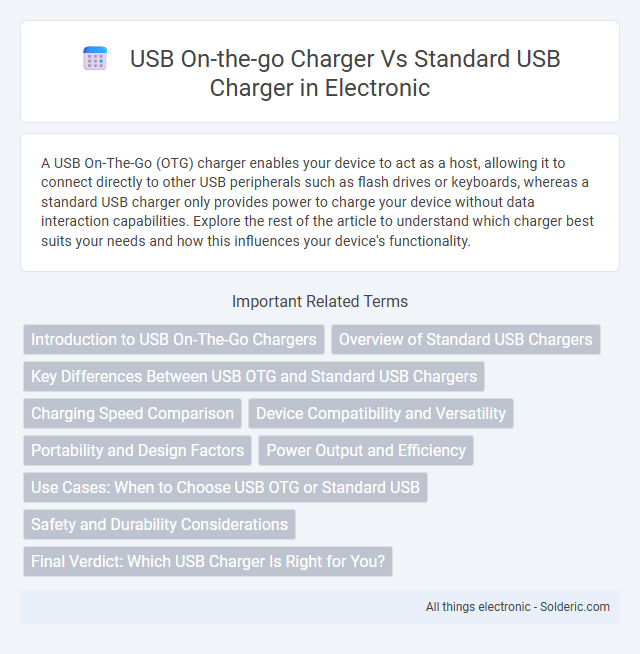A USB On-The-Go (OTG) charger enables your device to act as a host, allowing it to connect directly to other USB peripherals such as flash drives or keyboards, whereas a standard USB charger only provides power to charge your device without data interaction capabilities. Explore the rest of the article to understand which charger best suits your needs and how this influences your device's functionality.
Comparison Table
| Feature | USB On-The-Go Charger | Standard USB Charger |
|---|---|---|
| Functionality | Allows direct device-to-device power transfer and data exchange | Provides power to charge devices only |
| Compatibility | Supports OTG-enabled devices (smartphones, tablets) | Compatible with all USB-powered devices |
| Portability | Compact and often integrated in mobile devices | Varies; usually requires external power source |
| Power Output | Typically 5V, up to 2A depending on device | Varies from 5V/1A up to fast charging 5V/3A or higher |
| Data Transfer | Enables data exchange between connected devices | No data transfer capability |
| Use Case | Sharing files, charging through another device, connecting peripherals | Charging batteries of smartphones, tablets, and accessories |
Introduction to USB On-The-Go Chargers
USB On-The-Go (OTG) chargers enable devices to act as both host and peripheral, allowing your smartphone or tablet to directly connect to other USB devices such as flash drives, keyboards, or cameras without needing a PC. Standard USB chargers provide power for charging but lack data transfer and device-hosting capabilities. This dual functionality makes USB OTG chargers essential for users requiring versatile connectivity and efficient file management on the go.
Overview of Standard USB Chargers
Standard USB chargers provide a consistent and reliable power source for charging smartphones, tablets, and other USB-enabled devices, typically offering fixed voltage and current outputs such as 5V/2A. These chargers connect to a wall outlet and are designed primarily for power delivery rather than data transfer or device communication. Your choice of a standard USB charger ensures compatibility with a wide range of devices but lacks the flexible device-to-device charging capabilities found in USB On-The-Go (OTG) chargers.
Key Differences Between USB OTG and Standard USB Chargers
USB On-The-Go (OTG) chargers enable direct device-to-device power transfer and data exchange without requiring a PC, unlike standard USB chargers that supply power to a single device from a fixed power source. USB OTG chargers support dual roles, allowing a smartphone or tablet to act as both a host and a peripheral, whereas standard USB chargers only function as power sources. The key difference lies in the USB OTG's ability to facilitate portable device connectivity and charging versatility, making it ideal for on-the-go data access and power sharing.
Charging Speed Comparison
USB On-The-Go chargers typically support faster charging speeds due to advanced protocols like USB Power Delivery (PD) or Quick Charge (QC), enabling rapid power delivery up to 100W depending on the device compatibility. Standard USB chargers often provide lower wattage, usually ranging from 5W to 18W, resulting in slower charging times for modern smartphones and tablets. Choosing a USB On-The-Go charger can optimize your charging speed, especially for devices that support high-speed charging standards.
Device Compatibility and Versatility
USB On-The-Go (OTG) chargers offer enhanced device compatibility by allowing direct connection and power transfer between USB-enabled gadgets without needing a computer. Standard USB chargers typically provide power solely from an outlet to a device, limiting versatility for peripherals like flash drives or smartphones acting as hosts. Your choice of charger influences the ease of connecting diverse devices and maximizing functional versatility in daily use.
Portability and Design Factors
USB On-The-Go (OTG) chargers offer enhanced portability with compact, lightweight designs ideal for travel or on-the-move use. Standard USB chargers tend to be bulkier and less convenient for carrying, often designed for stationary use at desks or outlets. Your need for a charger that fits easily into pockets or small bags is better met by USB OTG chargers due to their streamlined, portable form factor.
Power Output and Efficiency
USB On-The-Go (OTG) chargers typically offer power outputs ranging from 5W to 15W, designed to both charge devices and enable data transfer between USB hosts and peripherals with optimized efficiency. Standard USB chargers generally provide a fixed power output, commonly around 5W to 12W, focusing solely on device charging without data communication capabilities. Your choice between the two affects charging speed and energy efficiency, with OTG chargers delivering enhanced versatility for connecting and powering multiple devices simultaneously.
Use Cases: When to Choose USB OTG or Standard USB
USB On-The-Go (OTG) chargers excel in scenarios requiring direct device-to-device communication, such as connecting smartphones to external peripherals like flash drives or keyboards without a computer. Standard USB chargers are ideal for straightforward power delivery to charge smartphones, tablets, and other USB-powered devices through a wall outlet or power bank. Choose USB OTG when data transfer and peripheral connectivity are priorities, while standard USB chargers suffice for regular charging needs.
Safety and Durability Considerations
USB On-The-Go (OTG) chargers feature enhanced safety mechanisms such as overcurrent protection and temperature control, reducing the risk of device damage during data transfer or charging. Standard USB chargers may lack these advanced safeguards, potentially leading to overheating or short circuits over prolonged use. Your choice should prioritize chargers with certified safety standards and durable materials to ensure long-term reliability and device protection.
Final Verdict: Which USB Charger Is Right for You?
USB On-the-Go (OTG) chargers enable direct device-to-device power transfer and data exchange, making them ideal for charging smartphones, tablets, or accessories without a computer. Standard USB chargers are designed primarily for power supply from a wall outlet to a single device, offering consistent and reliable charging for everyday use. Your choice depends on whether you need the versatility of OTG functionality or the straightforward efficiency of a standard USB charger.
USB on-the-go charger vs Standard USB charger Infographic

 solderic.com
solderic.com